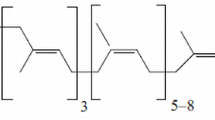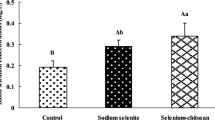Abstract
The impact of rosemary extract on splenic mononuclear cell proliferation was determined. Weanling male Sprague-Dawley rats were fed diets containing 0, 100, 200 or 400 ppm rosemary extract or 400 ppm butylated hydroxytoluene (BHT) in combinatiion with 10 or 20% casein enriched diets for 8 weeks. Splenic mononuclear cells were isolated from these animals and mitogenic response to Concanavalin A (Con A), Phytohemagglutinin (PHA) and lipopolysaccharide was determined. Con A and PHA-stimulated proliferation of spleen cells from rats fed 10% casein and 200 ppm rosemary extract was significantly higher than that of cells from the corresponding control animals. However, other levels of rosemary at 10% dietary casein or rosemary at any concentration fed along with 20% dietary casein had no impact on the mitogenic stimulation of splenic mononuclear cells. Thus, these results suggest that the use of rosemary might not have a generalized immunoenhancing effect, and will probably be effective in some stressed conditions, such as protein or antioxidant deficiency.
Similar content being viewed by others
References
Aruoma OI, Haliwell B, Aeschbach R, Loligers J (1992) Antioxidant and pro-oxidant properties of active rosemary constituents: carnosol and carnosic acid. Xenobiotica 22: 257–268.
Kim SJ, Han D, Moon KD, Rhee JS (1995) Measurement of superoxide dismutase-like activity of natural antioxidants. Biosci Biotech Biochem 59(3): 822–826.
Paris A, Strukelj B, Renko M, Turk V (1993) Inhibitory effect of carnosolic acid on HIV-1 protease in cell-free assays. J Natural Products 56(8): 1426–1430.
Favier A, Sappey C, Leclerc P, Faure P, Micoud M (1994) Antioxidant status and lipid peroxidation in patients infected with HIV. Chemico-Biol Interact 91: 165–180.
Moriguchi S, Kobayashi N, Kishino Y (1990) High dietary intakes of vitamin E and cellular immune functions in rats. J Nutr 120: 1096–1102.
Meydani SN, Meydani M, Verdon CP, Shapiro AA, Blumberg JB, Hayes KC (1986) Vitamin E supplementation suppresses prostaglandin E2 synthesis and enhances the immune response of aged mice. Mech Ageing Develop 34: 191–201.
Meydani SN, Barklund MP, Liu S, Meydani M, Miller RA, Cannon JG, Morrow FD, Rocklin R, Blumberg JB (1990) Vitamin E supplementation enhances cell-mediated immunity in healthy elderly subjects. Am J Clin Nutr 52: 557–563.
Nash DR, Steingrube VA, Warrington RJ (1983) Primary immune responsiveness and other observations in mice given oral dimethyl sulfoxide. Immunopharmacology 6: 191–201.
Dornand J, Gerber M (1989) Inhibition of murine T-cell responses by anti-oxidants: the targets of lipo-oxygenase pathway inhibitors. Immunology 68: 384–391.
Huang C-J, Fwu M-L (1992) Protein insufficiency aggravates the enhanced lipid peroxidation and reduced activities of antioxidative enzymes in rats fed diets high in polyunsaturated fat. J Nutr 122: 1182–1189.
Yasunaga T, Kato H, Ohgaki K, Inamoto T, Hikasa Y (1982) Effect of vitamin E as an immunopotentiation agent for mice at optimal dosage and its toxicity at high dosage. J Nutr 112: 1075–1084.
Babu U, Failla ML (1989) Superoxide dismutase activity and blastogenic response of lymphocytes from copper-deficient rats fed diets containing fructose or corn starch. Nutr Res 9: 273–282.
Jenkins MY, Sheikh NM, Mitchell GV, Grundel E, Blakely SR, Carter CJ (1993) Dietary carotenoids influenced biochemical but not morphological changes in adult male rats fed a choline-deficient diet. Nutr Cancer 19: 55–65.
Ahmann GB, Sachs DH, Hodes RJ (1978) Requirement for an Ia-bearing accessory cell in Con A-induced T cell Proliferation. J Immunol 121(5): 1981–1989.
Droge W, Schulze-Osthoff K, Mihm S, Galter D, Schenk H, Eck HP, Roth S, Gmunder H (1994) Functions of glutathione and glutathione disulfide in immunology and immunopathology. Faseb J 8: 1131–1138.
Grimble RF (1997) Effect of antioxidative vitamins on immune function with clinical applications. Intern J Vit Nutr Res 67: 312–320.
Freed BM, Rapoport R, Lampert M (1987) Inhibition of early events in the human Tlymphocyte response to mitogens and alloantigens by hydrogen peroxide. Arch Surg 122: 99–104.
National Research Council (1978) Nutrient requirement of laboratory animals, 3rd edn, p. 23, Washington, DC: National Academy of Sciences.
Author information
Authors and Affiliations
Rights and permissions
About this article
Cite this article
Babu, U., Wiesenfeld, P. & Jenkins, M. Effect of dietary rosemary extract on cell-mediated immunity of young rats. Plant Foods Hum Nutr 53, 169–174 (1998). https://doi.org/10.1023/A:1008040324935
Issue Date:
DOI: https://doi.org/10.1023/A:1008040324935




